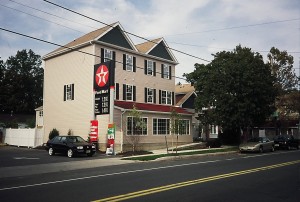Creative Affordable Housing
Smart Growth Awards Title: Rosner Complex, Delanco Township
Winner:Delanco Renaissance
 Although all New Jersey municipalities have a constitutional obligation to provide their share of affordable housing, many communities choose to transfer a large portion of their fair share obligation of affordable housing to another community through a Regional Contribution Agreement. The Burlington County town of Delanco Township, however, chose to seek out ways to keep its affordable housing in town – while simultaneously working to revitalize the town’s small downtown.
Although all New Jersey municipalities have a constitutional obligation to provide their share of affordable housing, many communities choose to transfer a large portion of their fair share obligation of affordable housing to another community through a Regional Contribution Agreement. The Burlington County town of Delanco Township, however, chose to seek out ways to keep its affordable housing in town – while simultaneously working to revitalize the town’s small downtown.
Although all New Jersey municipalities have a constitutional obligation to provide their share of affordable housing, many communities choose to transfer a large portion of their fair share obligation of affordable housing to another community through a Regional Contribution Agreement. The Burlington County town of Delanco Township, however, chose to seek out ways to keep its affordable housing in town – while simultaneously working to revitalize the town’s small downtown.
After the construction of a new age-restricted housing complex generated the constitutional obligation to build new affordable housing units, the mayor, town council, and the developer, Delanco Renaissance, decided to channel the affordable housing money generated by the age-restricted development into small scale infill projects that would not only provide the necessary affordable housing but also remove blighted and abandoned buildings in downtown Delanco.
The site that they chose to redevelop, the ½ acre Rosner tract, is located in the center of the community along its busiest road. The site is across the street from the Township’s middle school, one block from a bus stop, and within walking distance of the Township’s commercial core. There were three connected structures on the site including a two-story brick building known as the Colonial Building, with an attractive but crumbling front façade, and two deteriorating one-story masonry structures that many in the town considered eyesores. The Colonial Building had two apartments on the second floor that were in very poor condition; the downstairs and the adjoining masonry buildings had been used by a variety of commercial uses and at the time of the redevelopment, two were vacant.
The Colonial Building was rehabilitated, maintaining the same rooflines and saving the façade that gave the site its distinctive character. The interior was rebuilt into four one-bedroom apartments. To maintain visual interest and varied heights, the center one-story masonry structure was retained and a two-bedroom home was built inside. A peaked roof parapet was added to carry the design theme created by the Colonial Building.
The other masonry structure was converted into the mixed-use portion of the development. The first floor was converted into a restaurant that now provides a much-needed community gathering space that adds to the area’s street life. Above the restaurant are two “stacked townhomes” with two bedrooms each. Placing two two-story townhomes on top of the masonry structure added more height than is typically found in the community; to mitigate this, the roof was divided so that each of the stacked townhomes has a separate peaked roof. The peaks of these roofs match the pitch and shape of the peaked roof over the other two buildings on site.
Lastly, a detached garage in the rear of the property was removed, and two townhomes with front porches and bay windows have been built. An internal parking lot provides ample spaces for the residents and the restaurant staff. Restaurant patrons park along the main street, contributing to the sense of life and activity along the Township’s core road.
The development resulted in the construction of nine affordable rental homes. The Rosner tract is now fully occupied with community residents who take great pride in their new homes. This past holiday season, the homes were decorated by the residents with lights and candles; last summer, flower pots and gardens brought color and vitality to the new buildings. Delanco residents walk or bike to the restaurant for a meal or for one of the many civic events and meetings that are now held there.
This unique public-private partnership harnessed the abilities and resources of the private sector while providing an example of much of the good smart growth can bring a community: a revitalized downtown, increased housing choices, re-use of existing buildings, and new community space for the town’s 3,300 residents.











